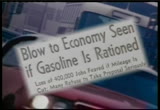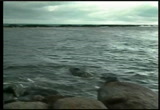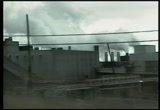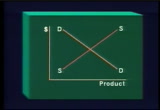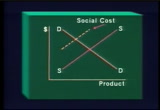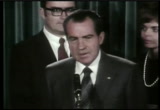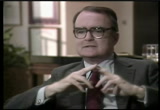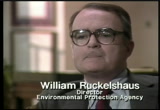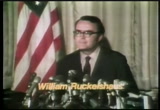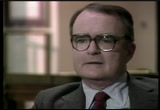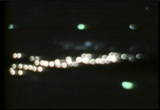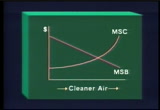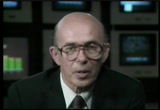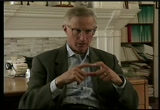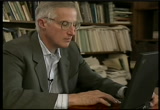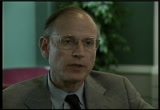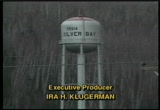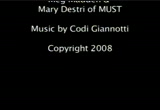tv Deutsche Welle Journal LINKTV April 29, 2013 2:00pm-2:31pm PDT
2:00 pm
annenberg media ♪ annenberg media ♪ there's an old saying thathe best things in life are free -- things like fresh air, sunshine, clean water. a company in minnesota found that "ain't necessarily so." what happened, and who should pay the cost of cleaning up the environment? and what happened when the environmental protection agency orderes angeles to clean u, no matter what the cost? should we spend billio to mitigate climate change? or wait and see what really happens? since the late 1960s, ere has been a consens among americans
2:01 pm
that the air we breathe and the water we drink should meet certain standards of cleanliness. but, like most things of value, those standards come with a price tag attached. pollution -- how much is a clean environment worth? economic analyst richard gill and i willxamine that question on this edition of "economics usa." i'm david schoumacher.
2:02 pm
the united states has always been blessed with vast natural resources, including some things we used to take for granted, like fresh water and clean, healthy air. but not any longer. in the past few decades, we've learned that industrial activity carries with it a substantial environmental price tag. if we want fresher water and healthier air, somebody is going to have to pay for it, as we found in the tiny town of silver bay, on the shores of lake superior. 30 years ago, this part of minnesota was practically a wilderness area. then, shortly after world war ii, some farsighteentrepreneurs decided there was money to be made in a rock called taconite, found here in abundance, near the famous mesabi iron range. they called their venture the reserve mining company.
2:03 pm
ruth erickson remembers the early days, before the trouble started. anybody that came here to work was in -- [ dog barks ] shush! -- was in bad shape economically. and reserve ilt the town, they furnished us with our medical facilities, fire, ambulance, everything. um... i can't say enough good things about reserve mining. schoumacher: taconite contains iron. t a lot, butnough to make a ofit, if younow w to crush it and separate therains of iron from the rest of the rock. and reserve knew how. but the refining process requires vast amounts of water and produces 2 tons of sandy residue, called tailings, for every ton of iron pellets. and that creates a problem. those tailings have to be put somewhere. and for years, the cheapest place to put them was the lake.
2:04 pm
that upset a lot of people, like environmentalist alden lind. the save lake surior associatiostarted in late '69 and came about largely because of concerns of people who lived in the silver bay vicinity about the impact of the tailings disposal on lake superior. schoumacher: it wasn't long before a new federal agency got involved. dr. phillip cook remembers. cook: i think there was ki of a gut action of people living in the area, who were... more environmentally concerned, that something that big was a problem. they didn't reallyat first, have any specific concerns, other than it looked like the lake was getting cloudy and there was obvious turbidity being caused in the immediately vicinity of the discharge. but, you're right, there was a feeling that this was a lot of material going in the lake. schoumacher: uneasiness soon turned to fear. in973, word got out that the tailings
2:05 pm
might contain asbestos, a known carcinogen. within a few weeks, much of the population of duluth, 60 miles to the west, had stopped drinking tap water. but was there a problem or wasn't there? cook: we knew we had tailings in the water. we knew that amphibole mineral was anmportant fraction of these tailings particles. we knew that some amphibole minerals, particularly the grunerite, which was in the tailings, can occur as asbestos, and that is associated with human health hards, particularly for cancer. um... what we didn't know was whether these rticular amphibole particles in the water occurred as fibers. so we took samples of the water and looked at it by electron microscopy and saw that, indeed, some of the amphibole particles were, that was kind of a shocking inrevelation to us.d.
2:06 pm
oh, i think it alarmed an awful lot of people. i think the first response was for an awful lot opeople to get very active, very quickly. there was a petition, i think, with something like 10,000 names presented to the mayor ofuluth insisting that something be done about this. schoumacher: duluth responded by building a new filtration system, but that didn't stop the protests. and we are, too, we're their neighbors. well drink out of the same lake. it's all our country. if... i don'knowpeople have to aw a line someplace on what kind of an environment they want toive in. schoumacher: that line was finally drawn in federal court. on what kind of an environment for the next four years, the answer's definitely yes, it'll delay it. claim followed counterclaim. hearing followed hearing. no. environmentalists produced expert witnesses who said the tailings were dangerous. reserve produced experts who said they were not and nted that they might be forced to shut down the plant if denied access to the lake.
2:07 pm
silver bay residents saw an economic catastrophe in the making. one-industry town. everything is dependent upon resee mining operating. schoumacher: in 1977, the federal court handed down its decision. after years of legal maneuvering by all parties, reserve reluctantly agreed to keep the silver bay plant open and to build a tailings disposal site seven miles inland from the lake at a cost of nearly $400 million. i really have nothing to say at this time. schoumacher: today, the water in these parts is certainly cleaner than it used to be, and probably safer, and reserve istill in the taconite processing business, with all the economic benefits it brings to silver bay. but the solution to the problem didn't come cheap. and it might not have come at all if the courts hadn't intervened. the sults of the reserve mining case
2:08 pm
showed that society was no longer willing to take a vast natural resource, such as lake superior, for granted. and it also showed tha the courts were now willing to force business to spend large amounts of money -- in this instance, hundreds of millions of dollars -- to clean up their act. the case also illustrated the way the american economy in t past had permitted business to orlook the social and vironmental costs of industrial enrprise, costs whicdon't often show up in a firm's bottom line. we asked economic analyst richard gill to explain why the governnt should get volved in cases such as this. the government has toetnvolve because a maet economy can'hand them. even the most devout proponents of a private, free enm recognize the need for publicnterntion in situations like that illustrated by the reserve mining case. technically speaking, the problem is wt economists call
2:09 pm
negative externalities of production. iss rather ncy jargon, when a business produces ironor other product, itas certain costs -- wages, rent for land, and so on -- that is has to pay for. but it also may impose other costs on society -- in this case, the pollution of lake superior -- for which it does not have to pay. thescosts are external to the firm and, indeed, eernal to the supy and mandal price system generally. anthis is impoannal because usually economists are quite imessed we're not onlyetermi the price , cuesor aarticur product, when wd and e quantity of the product producedhere, we're but we're alsoakinga statt cuesor aarticur product, when wd about costs and nefits roughly speaking, this demancues want product
2:10 pm
and the supply curve tel us how much it costs e society, roinerms of scarce resources,ues to produce t product. at the intersection of the two curves, the maet ectly balances the added satisfactionwe gt with the addedosof producin. the maet ectly balances utopia. but hardly utoa when we takea e with the addedosof producin. the maet ectly balances or, as oneongwriter t it but hardly utoa when we takea e r, from society'sr teethcin. the changpoinof view,ge e real costs of pducing this produc are not reflected in this ivate supply curve but by another curve of pduciup here,produc or en way up here. and the problem with this new curve is that ivathey don't have to payt veothese additionalosts and this is why the government,
2:11 pm
though howt shou steinis slig. [ chanting "save our earth!" ] schoumacher: 1970 marked a turning point in this country's battle against pollution. people were upset about america's they let our lawmakers deteknow how they feltt. on april 22nd -- earth day. ♪ the sun shine in. congress quickly passed a series of amendments to the clean air act which established higher air quality standards and faster timetables to reach them. they also created an agency to enforce the new laws. and in swearing in mr. ruckelshaus, i know that the attorneyeneral is very sorry to lose him, t as the first administrator of this vitally important agency. i'm very honored, mr. president. t as the first administrator of this vitally important agency. i promise do the best job that i possibly can. i'm very honored, mr. [ applause ]
2:12 pm
was the feeling back then that you could do a 100% job of cleaning up the enviroen yes, and a lot of that is reflected in the laws thatre still on the oks. there was a sense that we knew what the bad pollutants were, we knew how to measure them, we knew what the health and environmental effects of those pollutants were. we had technology that was reasonably ailable at a reasonable cost to essentially eliminate that pollution. that was -- all of that were assumions written into theaw at time. and many of ose assumpons are stilthere. written into theaw and byay,they're all w. at time. welllet's ke e cleaair ac the intento eliminate smog, awellthe elementsall w. how was at supseof smog? are nitrogen odeand hydrocarbons that interact in sunlight, they combine in sunlight and cause photochemical oxidants, or smog. now, those two pollutants -- hydrocarbons and hydrogen oxides -- come primarily, in places like los angeles, from mobile sources -- automobile. schoumacher: but how was the epa supposed to eliminate smog
2:13 pm
from a city where the car is king? county supervisor kenneth hahn had been wrestling with the problem for years. well, people in los angeles loved cars. uh, you grew up liking cars. you'd go over to a high school, you'll see more cars in the parking lot than you do bicycles. los angeles county has got five million trucks, buses, automobiles, motorcycles, and motor vehicles polluting the air. we're in a big garage. no wonder here, on certain days, the people will say the smog is harmful to their health. it is. a neighboring community turned around and sued los angeles, saying, "you're dumping on us." what was that all about? yeah, it was riverside. it is just north of los angeles, where -- this was back in the early '70s -- the parents of the children who couldn't play football in the afternoon
2:14 pm
because the smog levels were so high that they were ordered indoors finally got agitated enough that they sued the city, they sued the federal government. i was ordered by a court out there to impose, as the clean air act told me to, a transportation control strategy. they said the automobile controls are not going to make it by 1975. the law says you have to ensure that these standards are met by that period, and if you can't do it by imposing the controls on the automobile, then impose transportation control. we couldn't figure out what to do. the court threatened to hold me in contempt. it sort of boiled down to an issue of their mobility versus my freedom, so i flew out there and announced that 80% of the cars are going to have to get off the road. i am here in los angeles because, in the implementation of the clean air act, los angeles is really in a unique position. schoumacher: the epa's plan wasn't greeted with much enthusiasm.
2:15 pm
it would have been a federal disaster area. it would be as bad as a hurricane or a flood or an earthquake. to tell the people they can't use their automobiles to go to work or to go to school or to go to church is crazy. the chamber of commerce out there calculated that 400,000 jobs would be lost and there would be billions of dollars in adverse effect to the economy. had epa made any kind of calculation on that? under the clean air act, we were not allowed to take that into account in announcing a transportation or a land use control that would achieve the standard. removing that number of cars would have just devastated it -- economically. the air would have been cleaner, but there wouldn't have been -- people wouldn't have been able to get to the hospitals and other things. what was the philosophy behind the law that said, "we don't want to count cost"? the philosophy is just as i stated at the outset, that we thought we knew what the bad pollutants were,
2:16 pm
that we knew how to measure them, we knew the level at which the health and environmental effects occurred, we could get them below that level with a margin of safety, and we had the technology that could achieve that at a reasonable cost. all those assumptions are wrong. and if those assumptions are wrong, then the law that embodies those assumptions is bound to drive us to an irrational result. and it's just particularly obvious in a case like los angeles. schoumacher: as it turned out, the law which drove us to an irrational result was amended. los angeles was given a waiver, which allowed the city more time to clean up the air and lowered the standards it was expected to meet. today, the city of the angels drives on and on. the air isn't as clean as it would have been with 80% of the cars off the road, but neither is los angeles an economic basket case. the story of los angeles versus smog was only one of many conflicts that developed during the 1970s. cleaning up the environment, no matter how beneficial,
2:17 pm
wasn't going to be as easy, or as cheap, as we first thought. but does that mean we shouldn't try to clean up pollution? what are the economic principles involved? we asked economic analyst richard gill. well, one principle economists don't thk too highly of is what we might call the principle of perfection. it's a natural approach. we have these harmful external effects, let's get rid of them no matter what the cost. the 1973 plan for los angeles was a little like this. smog is harmful to your health. let's get rid of it, virtually outlaw driving for six months of the year. there are countless examples of this approach. nuclear generating plants involve certain hazards. let's ban them completely. alcohol leads to driving fatalities. let's bring back prohibition. the trouble with this approach is not only that it usually doesn't work -- the los angeles plan had to be modified -- but that it's bad economics.
2:18 pm
in our society, clean air has become a product. it brings us certain benefits, but it also has certain costs of production. and what economists want to do is to measure these benefits against these costs, taking, of course, all external effects into account. these look like ordinary supply and demand curves for our product -- cleaner air -- measured by some reduction of particulate matter, noxious fumes, and the like. but these curves do take external effects into account and are curves of social benefit and social cost -- more accurately, marginal social benefit -- msb -- and marginal social cost -- msc. what these curves tell us is that, as we produce cleaner and cleaner air, moving towards the right, the added social benefits begin to decline and the added social costs begin to rise. this makes sense intuitively, i think. reducing the first and worst air pollution
2:19 pm
brings us a lot of social benefit. getting extremely clean air is somewhat less important. also, as the los angeles case shows, producing somewhat cleaner air is not too expensive, while producing very, very clean air would have been disastrously costly. so what the economist says is apparently fairly simple -- keep on cleaning up the air until the added -- the marginal social costs begin to exceed the added -- the marginal social benefits, until the intersection of these two curves. i say "apparently simple" because measuring these social costs and benefits is not always that easy. schoumacher: from the 1990s and into the new millennium, we saw record floods, record high temperatures, more crop failures, longer droughts, melting polar ice caps,
2:20 pm
rising seas. most climatologists, though certainly not all, ree that thrising tperatures of the past several decades -- a phenomenon known as global warming -- are due to human activity. but there's more general agreement that the social and economic ramifications of trying to do something about the problem are enormous. both politicians and economists hotly debate the costs versus the benefits of how much to do and when to do it. to solve global warming, or to slowt, is likely to be very costly. and we're talking about not just millions of dollars, but billions of dollars and maybe tens of blions of dollars every year that we would have to spend to make a significant dent on the trajectory of climate over the years to come. but the costs of doing nothing are potentially catastrophic, because the changes in the climate which will occur
2:21 pm
are generally irreversible. schoumacher: december 1997. at the environmental summit in kyoto, japan, the world's developed countries pledge to cut their greenhouse gas emissions. stuart eizenstat was chief u.s. negotiator. eizenstat: the major agreements that we reached were for the developed countries to take specific targets -- on average, a reduction of about 5% from 1990 levels -- to be reached in the year 2001. schoumacher: in january of 2001, a new president assumed power and took another look at the kyoto agreement. president bush decided it would hurt the u.s. economy and announced he would not sign the accord. the decision by the united states not to participate in the kyoto accords touched off an uproar in european capitals. volatile protestors gathered
2:22 pm
outside the european union in gothenburg, sweden, in june of 2001, where president bush answered questions from the european press. we didn't feel like the kyoto treaty was well-balanced. it didn't include developing nations. the goals were not realistic. however, that doesn't mean we cannot continue to work together and will work together on reducing greenhouse gases. one can never forget that the united states is responsible for 25% of the world's emissions of greenhouse gases. schoumacher: natural scientists have pondered questions associated with greenhouse warming for a century, but the political, institutional, and economic issues have only begun to be considered. professor william nordhaus of yale university developed the first model of the economics of climate change a decade ago. now there are dozens of modeling groups worldwide. economic computer models permit governments to assess
2:23 pm
costs versus benefits of the kyoto protocol and alternative approaches. nordhaus: we want to know what the relationship is, historically, between the economy and the forces that are leading to climate change. and then in the future, we want to get our best, best guess as to what's going to happen to the economy and to the climate, and to the impacts of that on human societies over the decades to come. it's as simple as that. one of the conclusions of these analyses is and was that the kyoto protocol was neither going to make a big difference, nor very efficient. woman: how do you put a cost on new malarial outbreaks that are as a result of mosquitos having a larger range that they can live in because of changes in temperature?
2:24 pm
or the fact that mosquitos bite more when temperatures are one to two degrees higher? how do you put a cost on the relocation of millions of people in bangladesh that live at or below sea level? it doesn't make sense to just completely overturn your entire economy, because this is just one of the problems, just one of the threats we face. eizenstat: the ice caps which are going to melt aren't going to somehow reformulate. the sea levels which rise aren't going to suddenly recede. so that the damages which are likely to occur are already on a trajectory. what we need to do is interrupt that trajectory before it becomes too late. so, sitting back and doing nothing is not a prescription for reducing costs. it's a prescription for having catastrophic economic as well as social and environmental impacts. schoumacher: as the debate continues, scientists are searching for more accurate ways to forecast climate change
2:25 pm
and pinpoint its causes. this in turn will allow economists to refine their assessment. in november of 2001, the european union, along with japan and canada, ratified the kyoto accords, but the united states pulled back. still, it is expected that the differences eventually will be overcome and the entire international community will work together. for more on cost versus benefit as a policy tool, economic analyst nariman behravesh. unfortunately, the debate about global warming has generated more heat than light. environmental groups assert that global warming is an irreversible disaster that overwhelms all other problems that modern society faces. opposing groups assert that the earth has been on a warming trend for the better part of the last 500 years and that manmade emissions have not contributed much to this trend.
2:26 pm
environmental groups minimize the costs of implementing the kyoto accords. many business groups are concerned that such measures would hurt growth and raise the unemployment rates. the key economic lesson here is that resources are, indeed, limited. this means that we need to figure out cost-effective ways of dealing with global warming, as well as all the other problems facing our global society, including but not limited to poverty, disease, education, and national security. the good news is that we have made progress over the last couple of decades in improving the environment. few people would disagree that further improvements are needed. however, the benefits of these improvements need to be balanced against their costs. one challenge for both the supporters and opponents of the kyoto accords is to come up with better, and less exaggerated, estimates of the costs and benefits. america didn't get dirty overnight,
2:27 pm
and it's not going to be totally pure tomorrow. but thanks to citizen protest and government response, the country's environment is cleaner and healthier than it was back in 1970 when we first celebrated earth day. and now the challenges are even greater. but along the way, we have learned that if we want a cleaner environment, the way to get it may not be to take every last bit of pollution out of the air, the water, and the earth, but instead, to look for levels of cleanup that provide adequate safety at a price we can afford. this is david schoumacher.
2:30 pm
annenberg media ♪ annenberg media ♪ they were immigrant garment workers-- uneducated, unskilled, and underpaid. how could they fight for a living wage? after publishing over a century, the prestigious new york herald tribune closed during a strike. did the union kill the herald tribune? for 40 years, united auto worker presidents walter reuther, leonard woodcock, and douglas fraser won higher pay for their members. why in 1979 would fraser agree to take less?
284 Views
IN COLLECTIONS
LinkTV Television Archive
Television Archive  Television Archive News Search Service
Television Archive News Search Service 
Uploaded by TV Archive on

 Live Music Archive
Live Music Archive Librivox Free Audio
Librivox Free Audio Metropolitan Museum
Metropolitan Museum Cleveland Museum of Art
Cleveland Museum of Art Internet Arcade
Internet Arcade Console Living Room
Console Living Room Books to Borrow
Books to Borrow Open Library
Open Library TV News
TV News Understanding 9/11
Understanding 9/11
